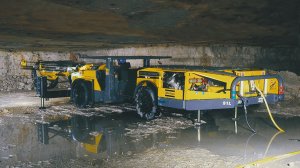Platinum miner says mechanisation, modernisation is only way forward

Amplats mining head Frik Fourie discusses some of the technologies the company is developing. Camerawork: Ilan Solomons. Editing: Lionel da Silva.
JOHANNESBURG (miningweekly.com) – To remain relevant in the South African mining industry, mines will have to substantially change how they operate and Anglo American Platinum (Amplats) mining head Frik Fourie does not see any future for conventional mining methods in South Africa.
“Conventional mining methods are no longer a profitable manner to operate mines in South Africa, which is exacerbated by current low commodity prices,” he told delegates at the Southern African Institute of Mining and Metallurgy’s Mining for the Future conference, held at the Electra Mining Africa 2016 trade show in Johannesburg.
Fourie said industry players including mines, government and educational institutions would have to come together. “We cannot, for example, continue to train people to change a wooden bunting (shaft guides) in a vertical shaft when they are going to be using a piece of mechanised technology instead.”
He explained that mechanisation was intended to remove mineworkers from dangerous work areas and could play “a valuable role” in the South African mining industry’s goal of achieving zero harm.
Fourie highlighted that research by the Chamber of Mines had shown that, if there was no substantial change in the mining methods used in South Africa, gold and platinum mining could cease in 2033 and 2029, respectively.
“So unless new mines start being developed and shafts sunk soon this nightmare could become a tragic reality,” he lamented.
Fourie added that Amplats also believed that with some modernisation of existing technologies and mining methods, along with the implementation of mechanised solutions at mines, this would provide the industry with much-needed breathing space to explore new ways of conducting mining operations in South Africa.
He commented that many people pointed out that most Australian, Canadian and South American mines were already mechanised and they were distressed as to why South Africa has been slow to mechanise its mines.
However, Fourie noted that unlike these mining jurisdictions, South African mines predominantly possessed very narrow reefs with widths of between 67 cm and 2 m with bands that declined at between angles of 180 and 350.
Nonetheless, he highlighted that South Africa did have mechanised mines, but that they mostly used bord-and-pillar mining methods with low-profile mining technologies, which were mostly imported from countries that are the leaders in mechanised mining such as Sweden and Russia.
He further remarked that dilution “kills us” as an operation that had a 60 cm to 80 cm reef width had to use low-profile equipment that was 2 m high. “If one mines at a minimum of 2.1 m depths, the dilution is 100%. Therefore, the amount of metal that mines actually retrieve is only 50% of all material mined.”
Another challenge faced by the local mines was that a lot of the mining equipment that was imported from Europe had rubber tyres and rubber tyre equipment could only operate up to angles of 110, which made them unsuitable for most mining reefs in South Africa.
Moreover, Fourie noted that South Africa had many social challenges. “Previously we were predominantly in a market where we supplied work to a large workforce and the expectation is that we still need to recruit [local community members] that live in the shadow of the headgear to use these new technologies.”
However, he said these were complex systems, which in most instances required highly skilled engineers to operate them, and most mining communities did not possess such skilled individuals.
Additionally, Fourie commented that a number of South African mines had old infrastructure and were very deep. “We are the only country in the world that has mines that operate at depths of between 3 km and 4 km underground. Additionally, we have limited capital resources and weak commodity prices add to the financial challenge mines face,” he stated.
AMPLATS' MECHANISATION STRATEGY
Amplats aims to produce 80% of its platinum using mechanised mining methods by 2023. The company started implementing this strategy in 2011. “We decided, then [2011], as the largest platinum producer in the world, that if we did not drive change in how the platinum industry operated no one would.”
Fourie stressed that the company had a strategy to mechanise and modernise its operations. At Amplats’ Amandelbult mine, in Limpopo, for example, the company is currently retooling its technologies with the aim of doubling the mine’s operating efficiencies.
All future Amplats operations will be highly mechanised with a significant emphasis on having remote controlled and/or automated machines, where possible.
“Our primary focus is to remove miners from high-risk zones as 80% of mine fatalities occur between the last line of support and the rock face,” Fourie highlighted. He added that Amplats also aimed to significantly reduce dilution volumes by implementing more efficient mechanised mining methods and solutions at all its operations.
At the company’s Twickenham mine’s Hackney shaft, in Limpopo – which is currently on care and maintenance – it has developed a new mine layout and is trialling a number of new technologies in the shaft. These include slot borers, platinum fuel cell powered ultralow-profile bulldozers, extralow-profile equipment (drill rigs and roof bolters) and a rapid mine development system.
Meanwhile, on Tuesday, Amplats technical executive head Gordon Smith told conference delegates that the company’s vision was to be global leader in the platinum group metals sector, from resource to market, to ensure a better future for all by repositioning its assets into a value maximising portfolio through the implementation of appropriate technological innovations.
He said the mining industry would continue to be faced with viability challenges as economic conditions and market requirements shifted over time. “We just have to deal with the cyclical nature of the sector.”
Smith remarked that the nature of the orebody defined a mine’s layout and design, which, in turn, was dictated by the technology that was available. Therefore, he said if companies evolved the technology, then a mine design could be changed and this would alter the economics of the operation, which would enable mines to be more flexible in different global economic conditions.
“The challenge really lies in effectively integrating all the components that make up the mining system, which consist of people, skills, processes and technologies.
If we are going to innovate and have technological developments at local mines it will require management to get on board, adequate funding allocation and continuous commitment,” Smith concluded.
Comments
Announcements
What's On
Subscribe to improve your user experience...
Option 1 (equivalent of R125 a month):
Receive a weekly copy of Creamer Media's Engineering News & Mining Weekly magazine
(print copy for those in South Africa and e-magazine for those outside of South Africa)
Receive daily email newsletters
Access to full search results
Access archive of magazine back copies
Access to Projects in Progress
Access to ONE Research Report of your choice in PDF format
Option 2 (equivalent of R375 a month):
All benefits from Option 1
PLUS
Access to Creamer Media's Research Channel Africa for ALL Research Reports, in PDF format, on various industrial and mining sectors
including Electricity; Water; Energy Transition; Hydrogen; Roads, Rail and Ports; Coal; Gold; Platinum; Battery Metals; etc.
Already a subscriber?
Forgotten your password?
Receive weekly copy of Creamer Media's Engineering News & Mining Weekly magazine (print copy for those in South Africa and e-magazine for those outside of South Africa)
➕
Recieve daily email newsletters
➕
Access to full search results
➕
Access archive of magazine back copies
➕
Access to Projects in Progress
➕
Access to ONE Research Report of your choice in PDF format
RESEARCH CHANNEL AFRICA
R4500 (equivalent of R375 a month)
SUBSCRIBEAll benefits from Option 1
➕
Access to Creamer Media's Research Channel Africa for ALL Research Reports on various industrial and mining sectors, in PDF format, including on:
Electricity
➕
Water
➕
Energy Transition
➕
Hydrogen
➕
Roads, Rail and Ports
➕
Coal
➕
Gold
➕
Platinum
➕
Battery Metals
➕
etc.
Receive all benefits from Option 1 or Option 2 delivered to numerous people at your company
➕
Multiple User names and Passwords for simultaneous log-ins
➕
Intranet integration access to all in your organisation



















